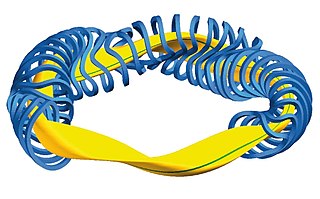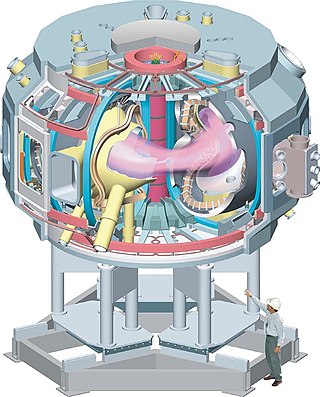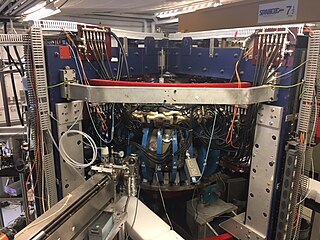Related Research Articles

A stellarator is a plasma device that relies primarily on external magnets to confine a plasma. Scientists researching magnetic confinement fusion aim to use stellarator devices as a vessel for nuclear fusion reactions. The name refers to the possibility of harnessing the power source of the stars, such as the Sun. It is one of the earliest fusion power devices, along with the z-pinch and magnetic mirror.

A tokamak is a device which uses a powerful magnetic field to confine plasma in the shape of a torus. The tokamak is one of several types of magnetic confinement devices being developed to produce controlled thermonuclear fusion power. As of 2016, it was the leading candidate for a practical fusion reactor. The word "tokamak" is derived from a Russian acronym meaning "toroidal chamber with magnetic coils".

Princeton Plasma Physics Laboratory (PPPL) is a United States Department of Energy national laboratory for plasma physics and nuclear fusion science. Its primary mission is research into and development of fusion as an energy source. It is known for the development of the stellarator and tokamak designs, along with numerous fundamental advances in plasma physics and the exploration of many other plasma confinement concepts.

The National Compact Stellarator Experiment, NCSX in short, was a magnetic fusion energy experiment based on the stellarator design being constructed at the Princeton Plasma Physics Laboratory (PPPL).

The Helically Symmetric Experiment, is an experimental plasma confinement device at the University of Wisconsin–Madison, with design principles that are intended to be incorporated into a fusion reactor. The HSX is a modular coil stellarator which is a toroid-shaped pressure vessel with external electromagnets which generate a magnetic field for the purpose of containing a plasma. It began operation in 1999.

Liu Chen is an American theoretical physicist who has made original contributions to many aspects of plasma physics. He is known for the discoveries of kinetic Alfven waves, toroidal Alfven eigenmodes, and energetic particle modes; the theories of geomagnetic pulsations, Alfven wave heating, and fishbone oscillations, and the first formulation of nonlinear gyrokinetic equations. Chen retired from University of California, Irvine (UCI) in 2012, assuming the title professor emeritus of physics and astronomy.
Ronald Crosby Davidson was a Canadian physicist, professor, and scientific administrator who worked in the United States. He served as the first director of the MIT Plasma Science and Fusion Center from 1978 to 1988, and as director of the Princeton Plasma Physics Laboratory from 1991 to 1996. He had been Professor of Astrophysical Sciences at Princeton University since 1991.
Ira Borah Bernstein is an American theoretical physicist specializing in plasma physics. He was the first person to formulate the theory of electrostatic waves propagating in a magnetized plasma in 1958, which are now commonly known as Bernstein waves in plasma physics.

Sir Steven Charles Cowley is a British theoretical physicist and international authority on nuclear fusion and astrophysical plasmas. He has served as director of the United States Department of Energy (DOE) Princeton Plasma Physics Laboratory (PPPL) since 1 July 2018. Previously he served as president of Corpus Christi College, Oxford, since October 2016. and head of the EURATOM / CCFE Fusion Association and chief executive officer of the United Kingdom Atomic Energy Authority (UKAEA).

The Hybrid Illinois Device for Research and Applications (HIDRA) is a medium-sized toroidal magnetic fusion device housed in the Nuclear Radiation Laboratory and operated by the Center for Plasma-Material Interactions (CPMI) within the Department of Nuclear, Plasma and Radiological Engineering at the University of Illinois at Urbana–Champaign, United States. HIDRA had its first plasma at the end of April 2016 and started experimental campaigns by December of that year. HIDRA is the former WEGA classical stellarator that was operated at the Max Planck Institute for Plasma Physics in Greifswald Germany from 2001 to 2013.
Norman Rostoker was a Canadian plasma physicist known for being a pioneer in developing clean plasma-based fusion energy. He co-founded TAE Technologies in 1998 and held 27 U.S. Patents on plasma-based fusion accelerators.

Víctor Iván Vargas Blanco is Costa Rican plasma and nuclear fusion physicist. He is renowned for his work in plasma physics and nuclear fusion. Currently, as a professor and tenured researcher at the Costa Rica Institute of Technology, he heads the Plasma Laboratory for Fusion Energy and Applications that he founded in 2011.

The Compact Toroidal Hybrid (CTH) is an experimental device at Auburn University that uses magnetic fields to confine high-temperature plasmas. CTH is a torsatron type of stellarator with an external, continuously wound helical coil that generates the bulk of the magnetic field for containing a plasma.
Masaaki Yamada is a Japanese plasma physicist known for his studies on magnetic reconnection.
Jürgen Nührenberg is a German plasma physicist.
Friedrich E. Wagner is a German physicist and emeritus professor who specializes in plasma physics. He was known to have discovered the high-confinement mode of magnetic confinement in fusion plasmas while working at the ASDEX tokamak in 1982. For this discovery and his subsequent contributions to fusion research, was awarded the John Dawson Award in 1987, the Hannes Alfvén Prize in 2007 and the Stern–Gerlach Medal in 2009.
The history of nuclear fusion began early in the 20th century as an inquiry into how stars powered themselves and expanded to incorporate a broad inquiry into the nature of matter and energy, as potential applications expanded to include warfare, energy production and rocket propulsion.
Alan Herbert Glasser is an American physicist.
Robert Anderson Ellis Jr. was an American physicist and head of experimental projects at the Princeton Plasma Physics Laboratory.
Thea Energy is an American fusion power company founded in 2022 after a spin-out from the Princeton Plasma Physics Laboratory (PPPL). Its original name was Princeton Stellarators, Inc (PSI). Thea Energy's approach to commercial fusion is based on the stellarator approach using a unique set of all-planar electromagnetic coils. This all-planar coil approach was developed by PPPL and licensed by Thea Energy.
References
- 1 2 "Francis F. Chen Biography at Springer.com". Springer . Retrieved June 8, 2017.
- ↑ "UCLA: Short Biography of Francis F. Chen, Professor Emeritus". UCLA. Retrieved June 7, 2017.
- 1 2 3 4 "UCLA: Publications of Francis F. Chen, Professor Emeritus". UCLA. Retrieved June 7, 2017.
- ↑ "Array of Contemporary American Physicists: Short Biography of Francis Chen, Professor Emeritus". Array of Contemporary American Physicists [aip.org]. Retrieved June 7, 2017.
- ↑ Goldston, Robert (2012). "Review of An Indispensable Truth: How Fusion Power Can Save the Planet by Francis F. Chen". Physics Today. 65 (2): 51–53. doi: 10.1063/PT.3.1441 .
- ↑ Chen, Francis F. (March 15, 1962). "Radial Electric Field In A Reflex Discharge". Physical Review Letters. 8 (6): 234–237. Bibcode:1962PhRvL...8..234C. doi:10.1103/physrevlett.8.234.